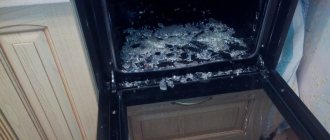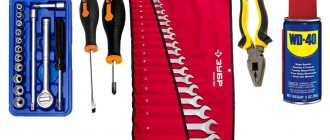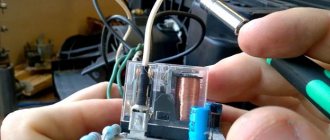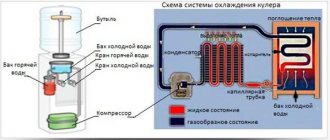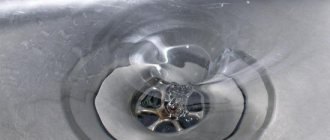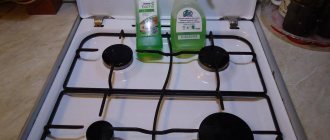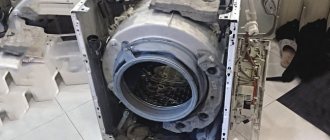The vast majority of owners practice repairing gas stoves on their own. Despite the strict prohibition of inspectors and linemen of local Gorgazov on interfering with the operation of gas appliances, amateur repair of the stove gives a good result and at the same time allows you to save a lot of money. A locksmith, without blinking an eye, will charge 50-100 dollars for repair work.
We stock up on tools to carry out repairs
To repair gas stoves at home, you will need a minimum number of tools, first of all:
- A universal screwdriver with interchangeable bits - a cross and a standard straight slot, pliers;
- Small adjustable wrench with side lip extension of 15-20 mm;
- Fum tape for gas appliances;
- Solid gas lubricant;
- Soft brush and highly effective detergent.
You can take “CIF”, “Cleaner” or any other liquid gel used to clean gas stoves with a stainless base from burnt-on fat. Sometimes, in extremely rare cases, you have to use a multimeter to repair a stove.
And, of course, you will need good health, at least there should be no runny nose, otherwise it will be difficult to detect a gas leak, and when working with gas appliances, the main condition for success is work safety. For the most serious work with coupling joints in a gas stove, you will need a watercolor brush and diluted liquid soap.
Is it possible to repair the console remote control?
Repairing a remote control for a set-top box is similar to restoring a regular remote control. The only thing is that before disassembling the equipment and trying to re-solder it, you should reset the remote control settings to the factory settings.
Instructions for resetting or updating your remote control settings vary depending on your digital TV operator. For example, to perform a reset on a device from Rostelecom, you must:
- Point the remote control at the TV and hold down the OK and TV buttons at the same time.
- Hold the command for two or more seconds.
- Wait for the LED to blink twice.
- Enter the numbers 977. The Power light should blink 4 times.
The code may vary depending on the model of the remote control, TV, or set-top box. But the sequence of actions is general.
Gas stove breakdown options
It is known from practice that the better the quality of the gas stove, the fewer reasons there are to disassemble and repair. Appliances manufactured in the CIS begin to break down after 3-4 years from the moment of commissioning, Turkish gas stoves can withstand 5-10 years of operation, German and Italian ones require repair no earlier than 12-15 years of service.
The most common failure cases:
- The electric ignition of the burners does not work, one or all at once;
- The automatic control of the burner flame front does not work;
- The smell of gas appears;
- Malfunction of the flame level regulator.
Of the above set, the most serious problem is considered to be gas leakage. If the smell of gas does not disappear when the gas stove is not working and the central tap is open, you will need to coat all joints and connections, from the supply hose or pipe to the regulator tap and nozzle.
Advice! If you are not sure that you can perform this type of diagnostics and repair yourself, then it is best to seek help from a specialist.
Key points for selecting a device
When choosing a locking mechanism for a gas pipeline, you should pay attention to the following characteristics:
- Pipe diameter. The tap must completely block the flow of gas into the apartment. If the shut-off element does not fit tightly to the walls of the gas pipe, then its tightness will be only partial, which can lead to serious consequences.
- Coincidence of diameter and thread pitch on the pipe and tap. In this case, installation of the device is quite easy. Installing a locking element with mismatched threads and diameters is, in principle, possible using adapters, but this will require additional material and time costs for the purchase and installation of additional parts.
- Hull integrity. The outer shell of the element must be free of cracks, chips, sagging and other defects. Their presence indicates a violation of the rules for transportation, manufacturing or storage of parts, which can lead to internal malfunctions, as well as a reduction in the service life.
You should also pay attention to the quality of the products, giving preference to models from well-known companies.
We repair a gas stove with our own hands
In a situation with a gas leak, there is nothing extraordinary; repairs can be done on your own, but you will need to take precautions, remove open sources of fire, organize a small draft in the kitchen, and use a hand-held battery-powered flashlight instead of stationary lamps.
Eliminating the smell of gas
First of all, to repair the gas system, you need to find the location of the leak. Most often, gas escapes through the windings on the couplings or union nuts of the hose with which the stove is connected to the outlet from the main tap. If the stove is made in the CIS countries, then gas can siphon through the nuts on the internal tubes running from the regulator valves to the burners. The third place of possible leakage is the gas supply regulators to the burners themselves.
To determine the location of gas leakage, you will need to apply a water-soap solution with a brush to all threaded pipe connections without exception. A leak can be detected by slowly rising bubbles. There is no other way to determine the location of the repair, except perhaps with the help of a special gas tester.
To repair, you need to turn off the gas valve and repack the joint with fum tape and gas lubricant. Inside the slab, paronite or silicone gaskets are used at all pipeline connection points, providing a very reliable and high-quality seal.
If the smell of gas occurs during operation of the gas stove, then the nozzle system with an air intake and flame divider is subject to repair. During repairs, the injectors must be cleaned with a cut match or a plastic needle. The air intakes are checked for the presence of dust or foreign objects, and the dividers are cleaned of settled gas combustion products with a thin wire.
Repair of faucet regulator
For gas stoves produced in the CIS countries, the most common breakdowns are the regulator taps. Such a valve is made in the form of two parts - a stationary body and a movable cone-shaped liner with holes. The cone is pressed by an insert spring and a drive rod, onto which a plastic burner control handle is placed.
The parts are made of brass; according to the technology, the cone must be ground into the valve body. If the valve parts were operated without lubrication, natural wear or wear on the cone would occur.
For initial repairs, you need to unscrew the two mounting screws and remove the cone, having previously marked its position relative to the body with a marker. Next, you need to remove the dirt, add a small amount of solid gas lubricant and reassemble the assembly in the reverse order. Such simple repairs can extend the life of a gas stove by several years.
Repair of cranes is carried out one at a time so as not to confuse the parts with each other. No other lubricant other than special gas can be used, otherwise the faucet will stick so that it can only be turned with pliers with enormous force.
For Italian or German stoves, faucet repair is generally irrelevant; thanks to the high quality of the metal and lubricant, the device can operate trouble-free for 15-20 years.
Correct repair of the electric ignition system
Most often, modern gas stoves are sent for repair due to a disruption in the stable operation of the built-in electric ignition system. In many cases, a complete failure does not occur; ignition may not work on one burner, or it may periodically appear and disappear alternately on several burners.
The system itself consists of four main elements:
- Contact pair installed on the control handle;
- Power supply systems, which include an ignition unit, a surge protector and a cord for plugging into an outlet;
- Four spark plugs, one for each burner;
- High voltage wires.
The latter are used to connect the spark plugs to a block-generator of high-voltage electrical pulses, one for each spark plug. The body of the gas stove acts as the second conductor of the high-voltage circuit.
Ignition repairs begin with disassembling the gas stove. Initially, remove the burners and remove the front top cover of the gas stove.
Ignition does not work on one burner
In the vast majority of cases, repairing electric ignition comes down to eliminating the short circuit between the high-voltage wire and the housing. The technological cavity located under the front cover is used for laying pipelines and wiring in the slab.
During the cooking process, water and some of the contents of pots and pans get inside the cavity and accumulate for a long time. Liquid substances, which most often have an acidic reaction, conduct current well, so even one drop that gets between the wire and the body can cause the auto-ignition to be repaired.
For high-quality repairs, all high-voltage wires must be cleaned, dried, placed in PVC tubes and fixed on plastic stands, without contact with the metal body of the gas stove.
In addition, heavily soiled spark plugs may be a reason for repair. The deposited grease deposits close the circuit, which leads to blocking the operation of the high-voltage unit of the system.
To perform repairs, you must perform the following manipulations:
- Remove the contact connector from the spark plug;
- Use a screwdriver and pliers to remove the retaining leaf spring and remove the spark plug;
- We wash the part in a strong detergent solution, clean, dry and install it in its original place, put on the connector.
For your information! Despite the assurances of gas mechanics, in approximately 95% of cases, problems with ignition operation do not require major repairs with replacement of the block, spark plugs or wiring.
Repairing stuck ignition on a gas stove
A situation occurs when the automatic ignition system begins to operate even when the burner control handle is released or turned off. The cause of the emergency is a short circuit of the control wiring to the body of the gas stove.
To repair, you first need to turn off the power to the gas stove. The next step is to remove the top panel and clean all high-voltage wires from dirt. If the unit is working properly, then the steps performed are sufficient for the initial repair of the device. It is imperative to clean and dry the entire technological niche of the stove.
Sometimes it happens that after releasing the burner handle, the spark plug continues to click for quite a long time. The reason for this situation is that the rotating mechanism of the faucet is heavily contaminated with grease, as a result of which the force of the return spring is not enough to open the contacts.
To repair the burner, it is necessary to remove dirt and lubricate the mechanics with a mixture of VD5.
Types of gas taps
There are many types of shut-off devices that are installed on gas pipes. Based on the features of their designs, two main groups can be distinguished:
Variety #1: cork
Until recently, this was the most common type of gas tap. The central part of such models is a conical element (plug) with a hole.
The main body of a plug valve is a cone-shaped insert with a hole in the middle. With its help, the gas flow is blocked or opened. The taps are made of brass or cast iron - durable, wear- and corrosion-resistant materials (+)
When opening the device using a flywheel, the hole in the conical part is aligned with the same one in the pipe, allowing gas to pass to the equipment. A gland is usually used to connect plug valves to the pipeline to create a seal.
Variety #2: ball
The main part of this type of locking element is a spherical part made of strong metal. As in its cork counterparts, it has a hole, which, when turning the handle, is aligned with the pipe, thereby ensuring access of natural fuel to the corresponding device.
Diagram of the operation of a ball valve: the main operating element of such a device is a round part that blocks the gas admission in the closed state and ensures the passage of flow in the open state
Such valves appeared relatively recently and quickly gained popularity due to their many advantages, namely:
- low cost;
- excellent functionality and safety margin;
- long service life;
- ease of operation;
- ability to work in various environments at temperatures from -60 to +80 o C.
Due to the combination of valuable qualities, experts now give preference to spherical structures when equipping household gas systems.
Unlike coupling and flange models, which can be used repeatedly, a welded valve is a disposable device and cannot be repaired
According to the method of connection to pipes, there are several subtypes of ball valves:
- Threaded (coupling). In this case, the tap is connected to a section of the gas pipeline using a threaded part.
- Flanged . Fastening is carried out using flanges fixed with bolts. Such devices are most often used when transporting gaseous substances and oil.
- Welded . In this case, the tap is firmly welded to the pipe using an appropriate apparatus.
According to their purpose, ball valves are divided into three types:
- Three-way, used for redistribution of gas flows;
- With a heated body, used in cold climates;
- With leakage control.
There is also a division according to the diameter of the passage.
According to this indicator, details can be classified into two categories:
- DN 10-50 mm;
- DN more than 50 mm.
Another classification takes into account the nominal pressure that the valve can withstand.
In this case, there are two types of devices:
- PN 1.6 MPa 16 kg/cm2;
- PN 4.0 MPa 40 kg/cm2.
Ball valves can be made from different types of metal. The most widely used elements are those made from brass, zinc, steel 20 and alloys (09G2S, 12Х18Н10Т), plastic.
The best qualities are demonstrated by brass devices, which can have a yellow or silver color (the latter is typical for nickel-plated models). Devices made from this alloy can be recognized by their relatively heavy weight.
Gas taps made of brass or bronze are recognized as the most wear-resistant and resistant to external influences. This device is characterized by its small size, reliability, ease of use, and high service life.
Featuring a robust, versatile design, brass taps are durable, low maintenance and can be installed in any position.
Malfunctions in the burner operation control system
Modern gas stoves are necessarily equipped with flame front control systems. A thermocouple tongue is installed on the burner, which receives heat from the flame. A heated thermocouple produces a small voltage at the contacts.
When the burner is turned on, the handle is recessed by 3-5 mm, which leads to the fixation of the opening tap on the electromagnet built into the housing. While the magnet receives voltage from the thermocouple, the gas valve remains open.
Repairing the control system is completely similar to the procedure for restoring the ignition system. Most often, the thermocouple is covered with a thick layer of deposits that interfere with the heating of the sensor. All repairs boil down to thoroughly cleaning the thermocouple and installing it in the socket.
Experts also recommend cleaning the contacts on the connecting wiring; the voltage is low, so even a thin layer of fatty deposits on the connectors can damage the system.
Resuscitation of buttons
Graphite conducts electricity well. If the graphite coating on the rubber button plate has worn off, you can replace it with a ready-made Chinese part. However, the cost of the part can be compared to the price of the whole remote control. In order not to waste money, you can repair the remote control at home.
Take:
- Foil from a pack of cigarettes, or any other foil on a paper backing.
- Good silicone based glue. You can use "Moment". There is no point in buying special glue for a one-time repair of the remote control.
- Scissors. Using scissors, you will cut out small geometric shapes from foil that match the shape of the remote control buttons.
If possible, you can buy a repair kit at a specialized store. The set includes ready-made buttons with conductive graphite coating and glue for attaching them.
How to repair the remote control:
- Disassemble the remote control;
- Take out the rubber button element;
- Place pieces of foil on the bottom of the non-functioning buttons. Place the paper side of the foil on the glue.
Repairing remote controls for Samsung smart TVs follows the same principles as work on devices from other brands. As you can see, repairing remote controls yourself is not a difficult task. It is enough to understand the general structure of the product. If you have an idea of how the remote works, you can effectively fix it yourself.
Repairing television remotes yourself is not always worth the associated hassle. Sometimes it is better to entrust remote control repairs to specialists.
A horizontal black stripe appeared on the TV screen
Disassembling the Samsung TV remote control
Setting up a huayu universal remote control for your TV
